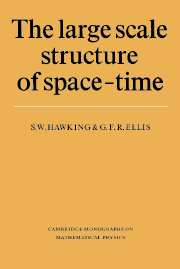Book contents
- Frontmatter
- Contents
- Preface
- 1 The role of gravity
- 2 Differential geometry
- 3 General Relativity
- 4 The physical significance of curvature
- 5 Exact solutions
- 6 Causal structure
- 7 The Cauchy problem in General Relativity
- 8 Space–time singularities
- 9 Gravitational collapse and black holes
- 10 The initial singularity in the universe
- Appendix A Translation of an essay by P. S. Laplace
- Appendix B Spherically symmetric solutions and Birkhoff's theorem
- References
- Notation
- Index
Appendix B - Spherically symmetric solutions and Birkhoff's theorem
Published online by Cambridge University Press: 26 January 2010
- Frontmatter
- Contents
- Preface
- 1 The role of gravity
- 2 Differential geometry
- 3 General Relativity
- 4 The physical significance of curvature
- 5 Exact solutions
- 6 Causal structure
- 7 The Cauchy problem in General Relativity
- 8 Space–time singularities
- 9 Gravitational collapse and black holes
- 10 The initial singularity in the universe
- Appendix A Translation of an essay by P. S. Laplace
- Appendix B Spherically symmetric solutions and Birkhoff's theorem
- References
- Notation
- Index
Summary
We wish to consider Einstein's equations in the case of a spherically symmetric space–time. One might regard the essential feature of a spherically symmetric space–time as the existence of a world-line ℒ such that the space–time is spherically symmetric about ℒ. Then all points on each spacelike two-sphere d centred on any point p of ℒ, defined by going a constant distance d along all geodesies through p orthogonal to ℒ, are equivalent. If one permutes directions at p by use of the orthogonal group SO(3) leaving ℒ invariant, the space–time is, by definition, unchanged, and the corresponding points of d are mapped into themselves; so the space–time admits the group SO(3) as a group of isometries, with the orbits of the group the spheres d. (There could be particular values of d such that the surface d was just a point p′; then p′ would be another centre of symmetry. There can be at most two points (p′ and p itself) related in this way.)
However, there might not exist a world-line like ℒ in some of the space–times one would wish to regard as spherically symmetric. In the Schwarzschild and Reissner–Nordström solutions, for example, space–time is singular at the points for which r = 0, which might otherwise have been centres of symmetry. We shall therefore take the existence of the group SO(3) of isometries acting on two-surfaces like d as the characteristic feature of a spherically symmetric space–time. Thus we shall say that space–time is spherically symmetric if it admits the group SO(3) as a group of isometries, with the group orbits spacelike two-surfaces.
- Type
- Chapter
- Information
- The Large Scale Structure of Space-Time , pp. 369 - 372Publisher: Cambridge University PressPrint publication year: 1973



